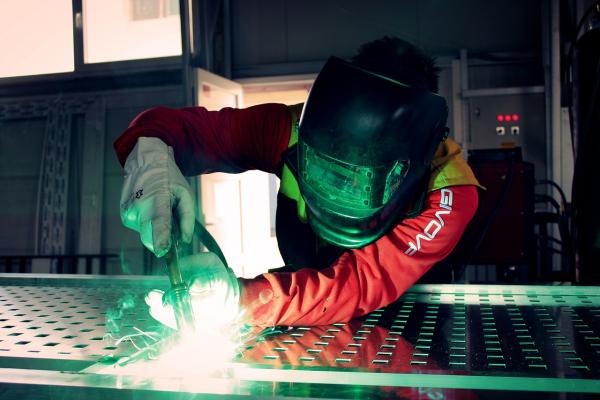What’s the Difference Between MIG and TIG welding?
MIG and TIG welding has some similarities, but there are different scenarios in which you might use one over the other. Both processes use an electric arc to heat and fuse metals together and can be run with either polarity based on the application, but the main difference comes down to how the filler metal is added to the weld.
- MIG welding (metal inert gas welding) – Filler metal is fed through the torch and requires a shielding gas or flux core wire to stabilize the arc. The main advantage of MIG welding is the speed and ease of learning.
- TIG welding (tungsten inert gas welding) – TIG welding requires a handheld tungsten electrode to generate the arc. Filler metal is added to the weld puddle by the other hand (except for machine or robotic applications). The benefit of TIG welding is that it provides greater control of the welding process and is typically very clean. The TIG welding technique is very similar to gas or oxy-acetylene welding.
Types of Welding Gases
When it comes to welding gases, shielding gases are most commonly used in MIG and TIG welding to protect the weld from oxygen and water contamination in the atmosphere. Water and oxygen can cause a lower quality weld and make the welding process more difficult for the welder. When it comes to shielding gas, there are two categories: inert and active gases.
What’s the Difference Between Inert & Active Gases?
- Inert Gas – Inert gases have no effect or reaction on the weld as it’s an inactive gas. The main purpose is to shield the weld from oxygen and water contamination. An example of inert gas is argon.
- Active Gas – An argon/CO2 mix is considered an active gas. Because it contains CO2, it causes electrical conductivity which affects the voltage of the arc and increases penetration. It also breaks the surface tension of the weld pool that is created which allows the molten metal to flow and flatten out.
Argon is the most commonly used inert gas for TIG welding projects. Since only a few gases can be used for TIG welding, argon is the most popular choice because it’s a versatile gas that can be used on a variety of metals including mild steel, stainless steel, and aluminum. Argon is also used to MIG weld stainless steel or aluminum.
Common active gases consist of 100% CO2 or an argon/CO2 mix, which will allow for a far better weld than using 100% CO2 because CO2 creates a more spattered arc vs. a smoother arc when using an argon mix. Pure CO2 is cheaper, but since it provides deeper penetration, it’s ideal for thick materials and cost-sensitive applications where appearance is not an issue. argon/CO2 and CO2 are commonly used to MIG weld carbon steel.
Things To Consider When Welding
- How thick is the metal you are welding?
If you’re looking to weld something extremely thin, you’ll want to lean toward TIG welding. MIG welding is less controlled so you’d typically want to use MIG welding for thicker metals.
- Are you looking to achieve a finished appearance without grinding?
If your weld requires needs to be presentable without post-weld operations, you’ll need a welding technique that allows for a smoother weld and no spatter like TIG welding. When welding items are hidden or if the weld bead is allowed to be raised and somewhat rough then MIG welding will be perfectly adequate.
- Do you need to produce liquid or gas tight welds?
It is difficult to produce leak-free welds with a MIG because the weld is cold briefly after the arc is struck before the metal starts to fuse. TIG is a better fit for gas or liquid-tight welds.
- How much time do you have to finish the project?
If you’ve got a deadline to hit, your friend will be MIG welding as it can weld thick and thin metals and lays down filler metal much more quickly. MIG is typically the best choice for longer, continuous welds.
Before You Go…
The type of gases you use as a shielding gas is a major element of a successful weld. In order to pick the right gas mixture or steel supply for your next project, speak to one of our welding team members for guidance and recommendations based on your project. Contact us at 303-776-1491 to speak with one of our experts.
Sources:
https://www.thewelderswarehouse.com/Welding-Supplies/Mig—Tig-Shielding-Gases.html
https://www.marlinwire.com/blog/how-to-compare-and-choose-between-mig-and-tig-welding

